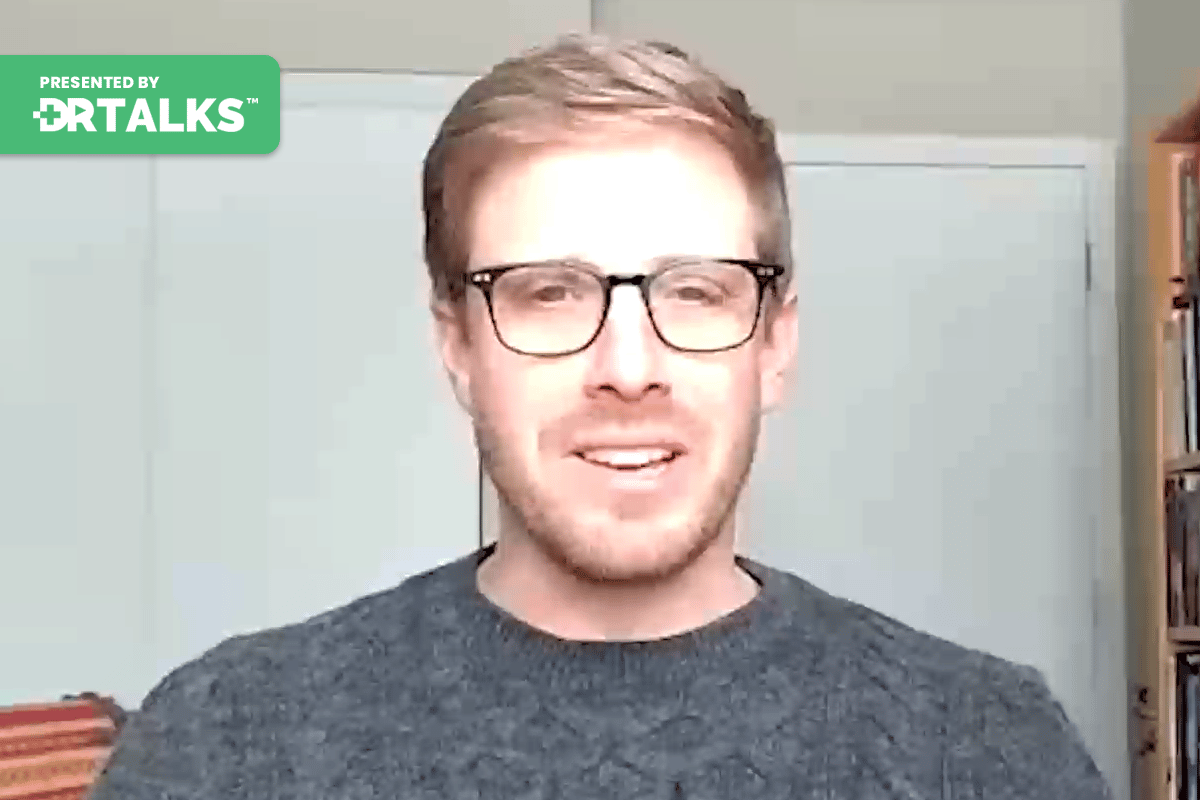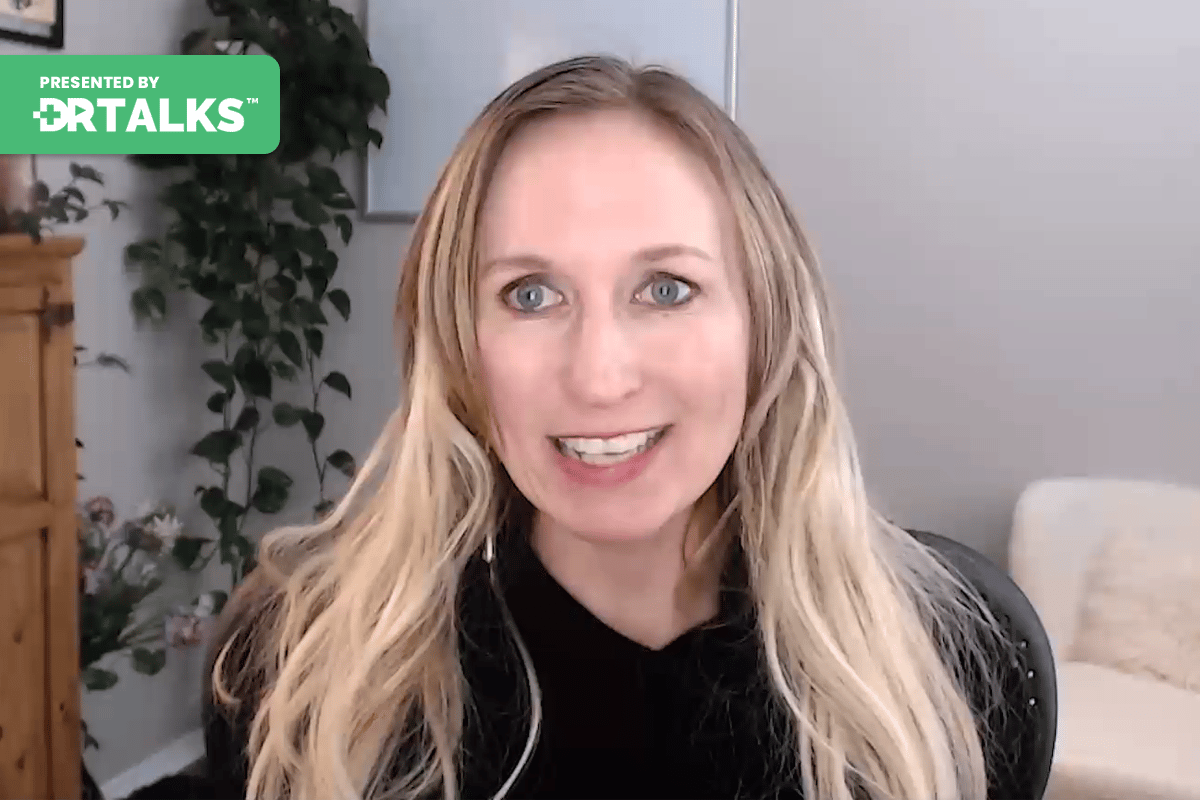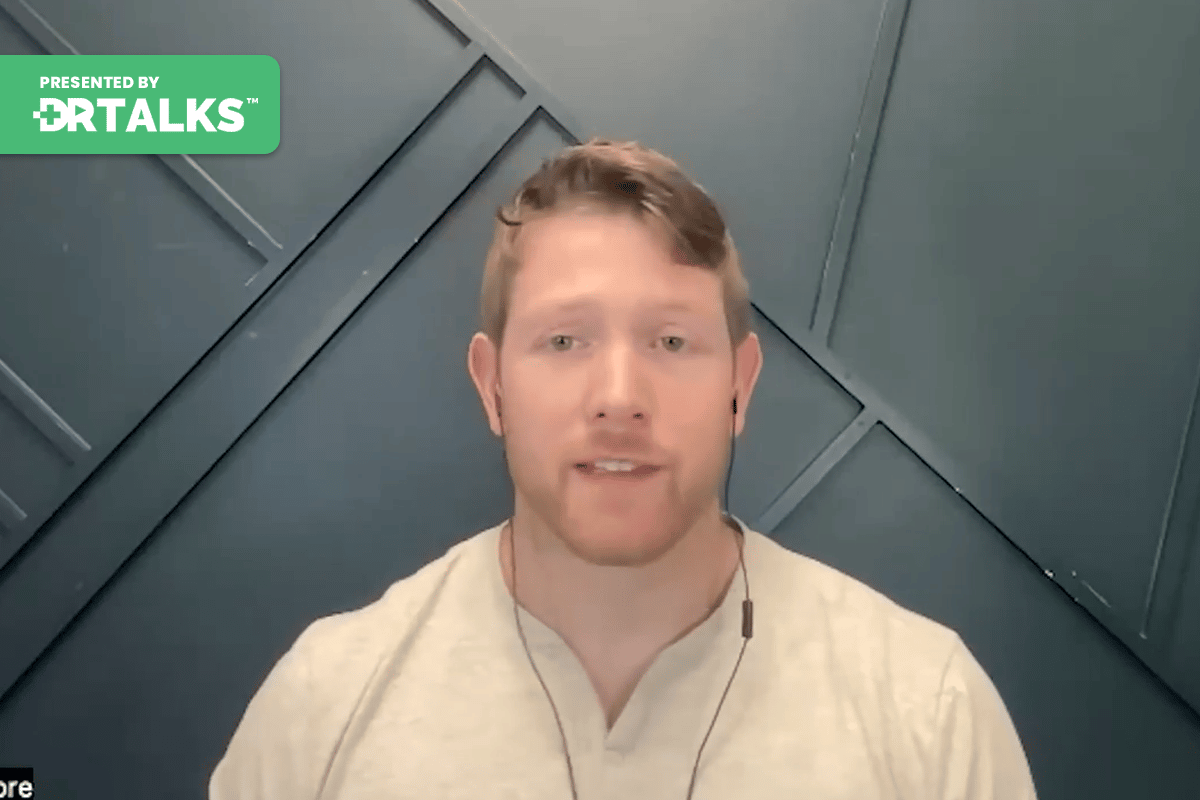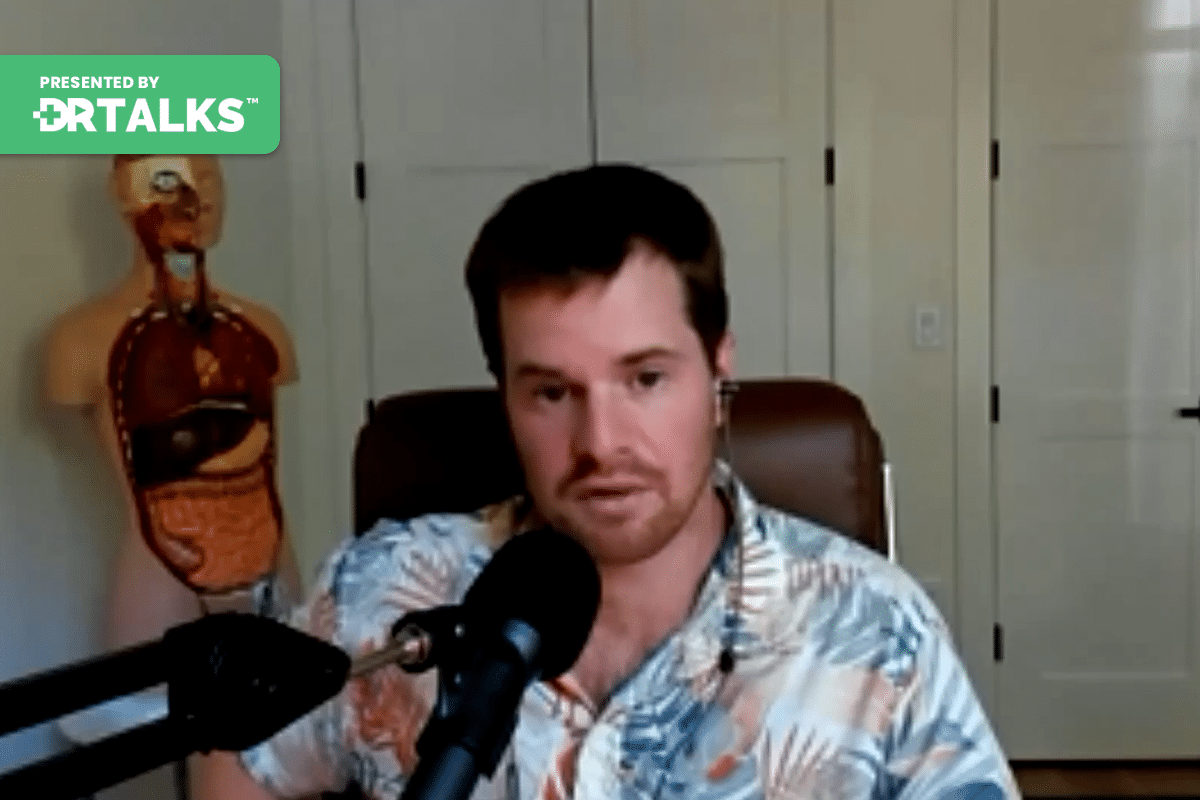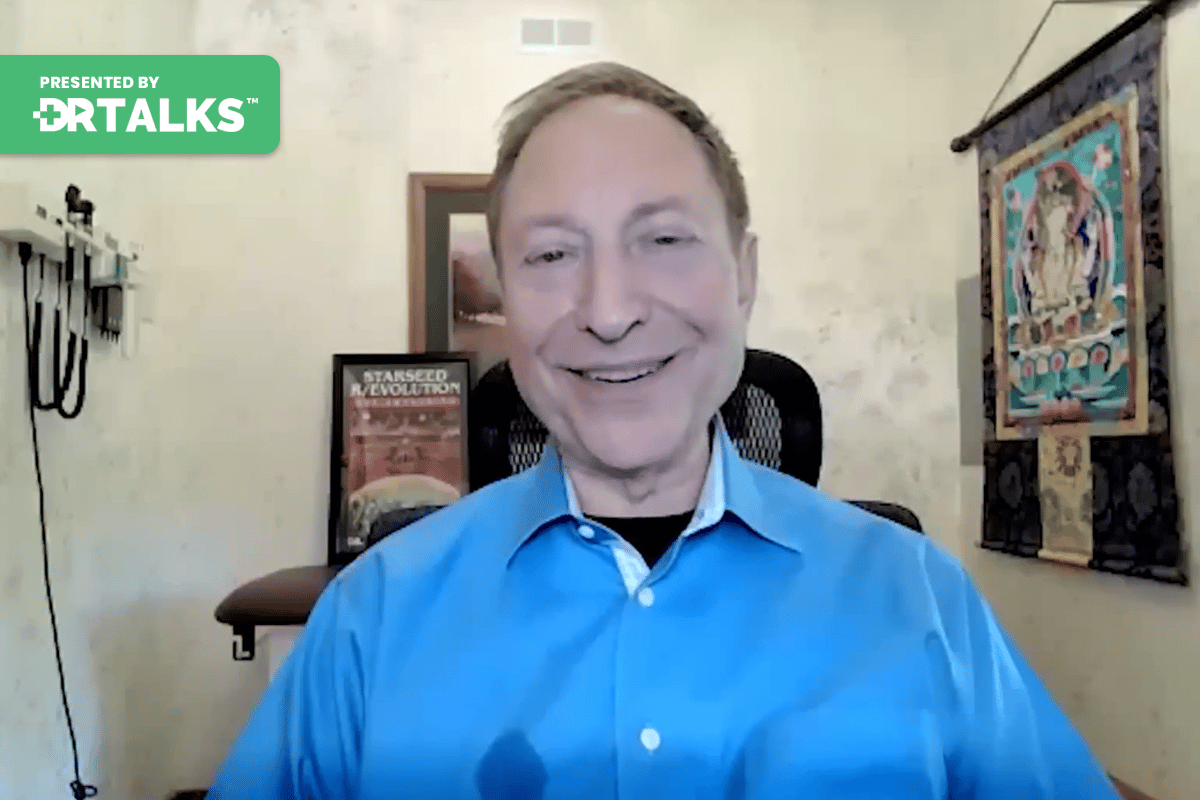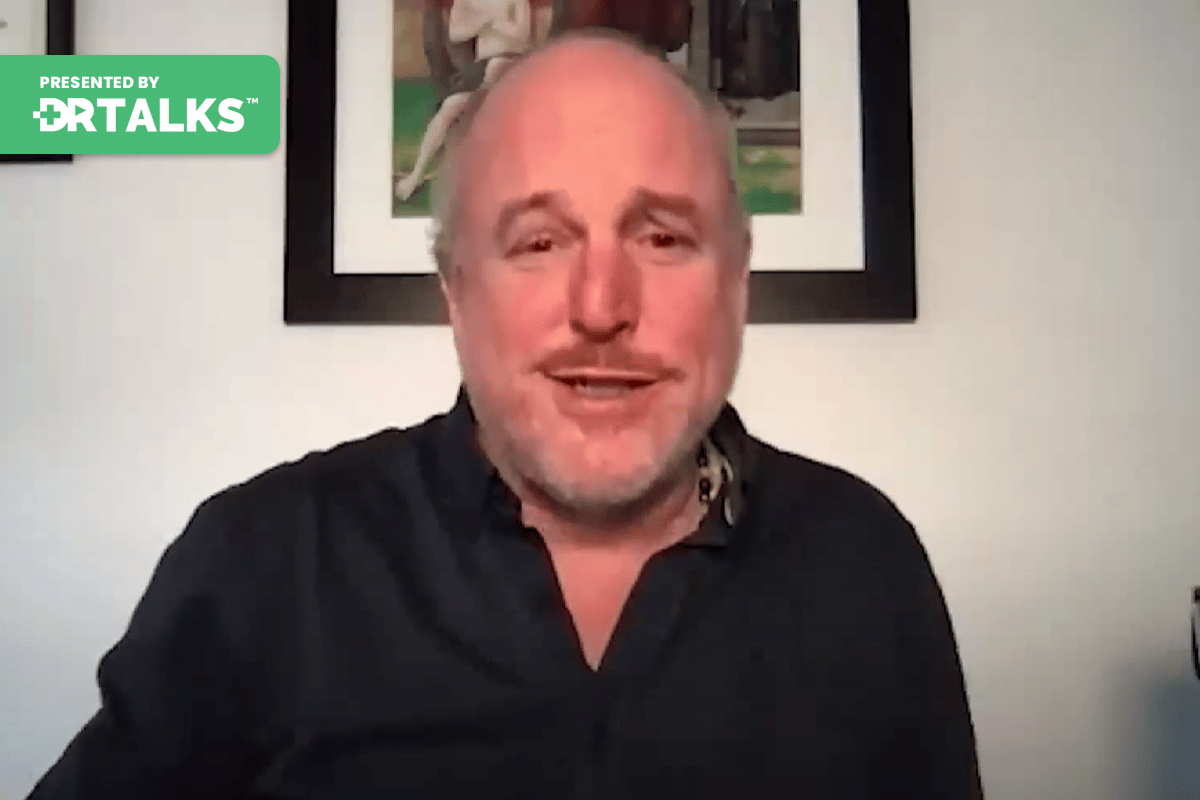Join the discussion below
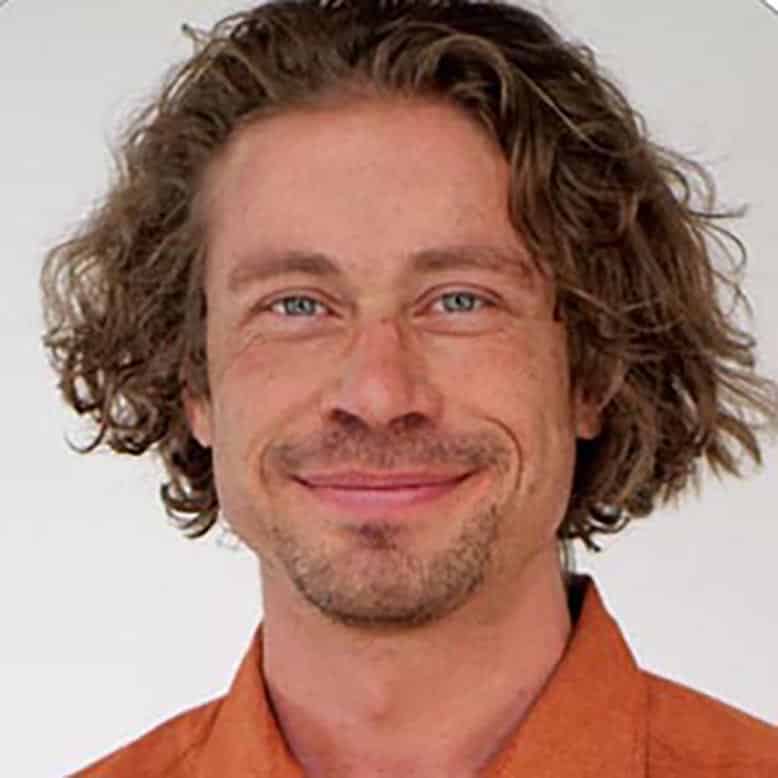
Dr. Miles Nichols is a functional medicine doctor specializing in Lyme, mold illness, gut, thyroid, and autoimmunity. After Dr. Miles personally struggled with chronic fatigue in his early 20’s, Dr. Miles dedicated himself to figure out the root causes. He suffered with and recovered from thyroid dysfunction, autoimmunity, a gut... Read More
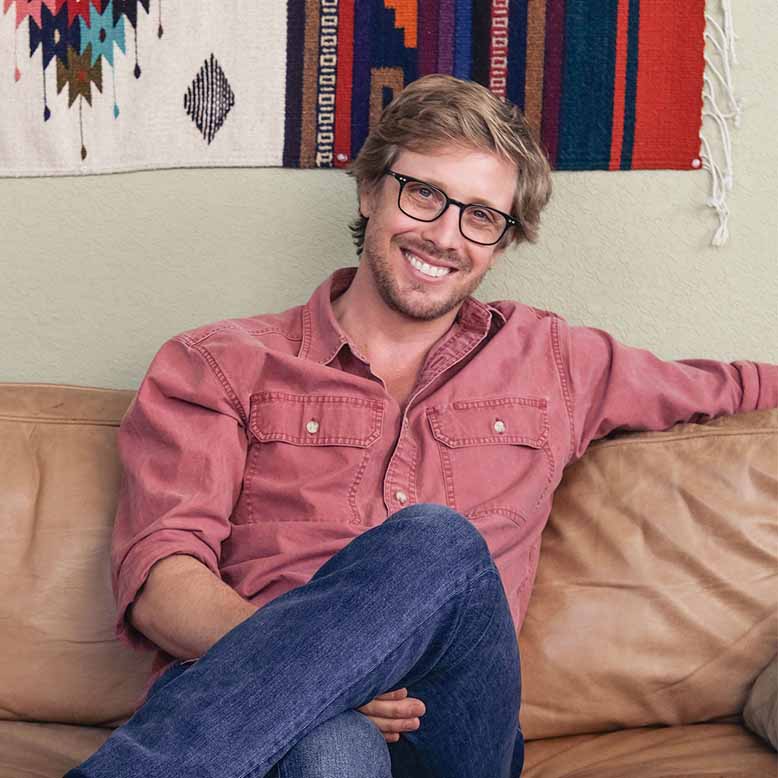
Pierre Bouchard is a Licensed Professional Counselor with a group practice in Boulder, CO. He specializes in blending somatics, embodiment, attachment theory, and trauma therapy with ketamine-assisted psychotherapy. A graduate of Naropa University (in Contemplative Psychotherapy), he has trained in several somatic psychotherapy modalities, most recently the Hakomi Method under... Read More
- Integrative approaches to counseling including somatic therapy, buddhist philosophy, and attachment theory
- How psychedelics such as ketamine can play a role in the therapeutic approach
- Psycholitic vs psychedelic dosing and opportunities
- Subtle trauma of complex chronic illness and mental health issues as pressure on the nervous system
- Ketamine assisted psychotherapy and opportunities for transformation
- Healing to awaken vs awakening to heal
- Differences between ketamine, psilocybin, and MDMA
- Integration between functional medicine and psychedelics
Dr. Miles Nichols
Hello everyone and welcome to the microbes and Mental health Summit. I’m your host, Dr. Miles Nichols. And today I’m here with a friend, a colleague. Someone who I actually had some time in the master’s program with Pierre Bouchard. Pierre is has done really fascinating things with his career and he works with a blend of somatic therapies and attachments theory and trauma therapy with ketamine assisted psychotherapy. And I’m really fascinated by the experiences that I’ve had witness to for people undergoing these kinds of therapies and by peers, immense clinical experience. Welcome Pierre to the summit.
Pierre Bouchard
Good to be here.
Dr. Miles Nichols
I want to start with a little bit of your background, whatever you’d like to share of your story of how you became what your journey was to get to the point of being interested in working in this arena.
Pierre Bouchard
Yeah. So like you said, you and I met the Europa Contemplative psychotherapy program which I went on to finish as the base of my clinical practice. And while I was studying there I got really interested in somatic psychotherapy and then combining that with buddhist practice and Contemplative Practice sort of became the foundation to understand sort of working with trauma through the lens of the body and the nervous system. When I was doing that I happened to have a mentor at the time who was part of phase two of the M. D. M. A assisted psychotherapy clinical trial through maps and was hearing just these unbelievable results of working with M. D. M. A. And trauma therapy which really started to put this on my radar and soon after that I was lucky enough to be introduced to a ketamine which is legal now. Whereas M. D. M. A. Is still shortly is still only available in clinical trial. Although will be available quite soon we’re hoping. But I was introduced to ketamine as a medicine for using in conjunction with therapy and after over a period of time did a mentorship with a therapist who was working with this and started incorporating it into my clinical practice. That was some years ago now and I’ve had the benefit of doing well over 100. Excuse me, 400 sessions with folks Working with a lot of P. T. S. D. Working with depression and using it to work with a variety of mental health issues that often we can then use the ketamine to get much deeper into the roots of where these things have come from. And I’ve seen some really gorgeous results.
Dr. Miles Nichols
Amazing. And for the audience I think a lot of people know what ketamine is but just in case ketamine is a drug that had it had applications first as an anesthetic and is has been used in surgeries for a long long time. But it has some interesting properties that make it unique. And one of those properties is that it produces at doses that aren’t quite putting people completely under. It produces an interesting effect a psychedelic effect for people. And at some doses a sub psychedelic but altered state for people. And unlike some other anesthetics which can be quite dangerous when used outside of an anesthesiologists office. The academy actually has this property of rather than blood pressure dropping quite low and becoming dangerous blood pressure actually stay stable or even goes up a little bit. So it people don’t have that same risk with other anesthetics and it tends not to have the heart rate becoming abnormally low. So it’s useful it’s very tolerated, well tolerated and it’s of course a controlled substance. So it’s under the guidance and the prescription from a physician. But it is one that has shown to be safe or use in a way that many other anesthetics have not. And it produces this very interesting altered state. Is there anything you’d like to add about ketamine and the effects of ketamine?
Pierre Bouchard
Yeah. So thank you for that. Yeah. Well what we’re seeing with it clinically is that within the therapeutic range which is of course sub an aesthetic We have you can break down into sort of 22 areas. Right? So we have sort of a lower dose where there’s a people are opened up and they’re able to do some work with their psychology. And this this is I’m breaking this down into sort of two categories and these are not my categories actually stan grof came up with these categories in the in the sixties when talking about working with LSD and we what what I’m describing here is sort of a basic differentiation strategy that can be used then with other psychedelics as well, potentially. So at the lower dose, what we call is this we call this a psychologic dose and what this is is that the psyche is opened, there is more flexibility and this is a really nice range where people still feel like they’re in the room, there’s there, they’re very much altered, they’re having a difference of sensation. And one of the things that ketamine does is as a dissociative anesthetic is that it creates a sense of distance from the experience, which is one of its most useful attributes. This allows people to have a bit of a bird’s eye view often of what’s going on in their life. There’s something about that distance that can then allow them to look at things a little differently, there’s a change in perspective and sometimes that also means just a bit of a distance from something really painful, thus allowing them to do some processing around it that otherwise would have felt too overwhelming. So this is a psychologic, this the psychologic range and this is what I specialize in working with. We’re using a window of time where the person is on the medicine and that we can get in there and do some really deep psychotherapy work, they still have an ego, they still have a sense of themselves. It’s just a bit more flexible now.
If we talk about rage, raising that dose, we get into what’s called more of a psychedelic range. Now, this is what we’re seeing as you know, full release, full ego death, maybe not feeling like they’re in the room anymore. The sense of time and space become a lot, lot more flexible if not totally meaningless. And what we’re seeing here clinically is that there’s something about being so outside of one’s perspective that that can also be very helpful in breaking some of the tight patterning that people have around particular issues. Now, the challenge with that is sort of integrating the experience back once they’re back. But that can be a really meaningful and potentially life changing kind of experience for folks. We’re seeing that kind of dozing strategy also used with psilocybin, particularly with end of life work. That’s 11 place where the research has been. But that often the bigger experiences with that medicine also are producing really lovely results for folks.
Dr. Miles Nichols
That’s great and it’s important to touch on integration. So, I know we’ll want to go there at some point in our conversation here because having an experience is different than integrating that experience into the structures of the personality, of the ego, of the life going forward. And so it can be a fun time or it can be a transformational experience and there’s a difference between those. So we’ll want to touch on that a little. So in relation to before we go into integration and stabilization of this experience, I wanna backtrack a little bit into that. You mentioned somatic, you mentioned buddhist philosophy, you mentioned a trauma work and so that we can give people a little more context before we go further in the psychedelic aspect of things, which I know people are excited to learn more and we want to go into more, tell us a little bit because the the education where we met at Europa, it’s very different than some of the traditional psychological approaches. So tell the audience what is somatic therapy and some of the ways in which you work with trauma that are informed by buddhist philosophy that may be a little different from traditional counseling.
Pierre Bouchard
I’ll try and say this distinctly, the quickest way to learn anything is to have an experience and it’s hard to have an experience without being mindful of it. And so contemplative therapy is about helping people to pay attention to in the moment, what’s happening for them. And this is also true of somatic psychotherapy where we’re using the avenue of the body of physical sensations, of emotions, of felt impulses as another channel of data besides thoughts and pure emotions to find out what’s happening for us and I don’t know about you, but I can convince myself of just about anything given enough time. Whereas sensations in the body are a bit more objective in that way. You know, it’s like something I’ll see a lot with clients is something challenging will happen for them in their lives and they’ll come in and say, oh I’m fine. And I believe them, I believe that they believe that they’re fine and when we have them turn their attention to their body a little bit, what we’ll find is often there’s some heaviness in the chest and if they stay and allow themselves to pay attention to it.
The sensation there actually grows and my way of understanding that is that that was there the whole time. They were just not accessing that channel of information and that by doing that, it actually opens into a world of feeling that might have been skipped otherwise. So, somatic psychotherapy is all about helping people to use this other channel too discover what’s true for them and how then the body is manifesting, belief because this isn’t just about direct sensation. It’s about how is belief. How is person verbally actually showing up in how we occur or don’t occur in the world. So what we’re finding here is how then the body is showing us how and how a person is or is not occurring. It’s this wonderful intersection of sensation and structure and how that is an intersecting with meaning, meanings we make about ourselves and how we’re allowed to be in the world or not.
Dr. Miles Nichols
I love that the meanings we make about ourselves and being in the world or not.
Pierre Bouchard
That’s also asked me something about. So that’s a bit about psychotherapy, About somatic psychotherapy. Now, to say a little bit about trauma here Is any experience that is too much for us to handle in a moment. And that what we find is what we’ve been finding for the last 30 years in the research here is that that ends up getting stored in the body and that gets stored in muscle tissue that gets stirred and stored in the nervous system. And I’m sure you could tell me a lot more about how that gets stored in organs or in other ways but what we find is that challenging experiences that are too overwhelming to be with as they’re occurring, end up living with us in an ongoing way if they’re not able to be integrated. And so this is where, as I was saying earlier, the fastest way to learn anything is to have an experience. And so what’s this, this is where we can use a person’s body and their experience of themselves, as the way into starting to unwind through the nervous system, traumatic experiences. They’ve had traumatic memories.
Dr. Miles Nichols
Yeah, yeah, that’s really important. And I know that a lot of people have been told and experienced and then later had the experience and realized how off their cognitive understanding was, for example, if before you’ve ever fallen in love and someone tries to describe what it’s like to fall in love and then you think you have an idea of what it’s like to fall in love and then you fall in love and realize, wow, that’s very different than what I thought that was going to be like because the cognitive understanding is different than the experiential process and in trauma as well. I think that aspect of that when we’re talking about trauma is something that is not being able to be fully present with an experience because of the experience and the intensity of the experience and that can get stored in the body, that there is this subtle aspect. It broadens the spectrum. It’s not a clinical, only this trauma as this clinical experience that gets in the way of day to day function. Like PTSD diagnostics, we’re actually talking about a wider spectrum here of experiences because it could be an experience that is more than a person can handle.
Could be something that you can function quite well with in your life. But it just occasionally comes up a little bit or it holds itself in the body and creates a little bit of physiologic dysfunction. Maybe there’s a little bit of pain or a little bit of chronic inflammation or a little bit of organ system dysfunction that results from that and that limbic system in the brain that trigger response. And this happens, I believe with chronic illness and mental illness all the time where people especially are being told that nothing is physically wrong and that it’s all in their head and they’re trying to figure this out and that can create its own trauma. We see medical trauma being created in the medical world where people are not being recognized for their experience. If they’re feeling off, they’re being told that that’s not medically often it must be in their head. But there’s a lot involved and research is discovering a lot about how subtle trauma, how non diagnostic trauma can actually impact the physiologic body and vice versa.
How physiologic aspects like infections were talking in the summit a lot about microbes and how microbial infections can actually impact the brain cross react with brain tissue causing autoimmune response. But then the symptoms of that can lead to this chronic illness. Picture chronic fatigue, brain fog, depression, anxiety and that then can lead to my life compared to others around me is a struggle and that can become its own traumatic experience and lead to olympic triggering and lead to trauma stored in the body and that can circle into creating a pattern that’s very hard to get out of. Even when the infections are treated, it can lower the burden. But there often are still some mind body approaches that are needed in order to unpack some of the stored trauma in the body. So anything more you’d like to say on that and or add anything related to attachment as well.
Pierre Bouchard
Yeah, Well, I mean, I think you’ve said it really well, you know, I’m sure as many of your listeners will know probably firsthand the experience of knowing something is not right and not having a way to describe that or having confusion about that because something is really challenging to diagnose. I mean, just the reality of living with a sense, something’s not right. You know, that is a low grade stressor on the system all the time, Right? It’d be like, if you heard a fire alarm, you know, going off in the other room constantly, but you couldn’t find it that would bother you. That would be that would be stressful, you know, and that that as a sustained experience over time has a toll that it takes on the body, on the nervous system. That’s a nervous system, that’s not allowed to opt to operate at optimal functioning, then it’s always attending to something and you know, to bring this back to a little bit more of a psychological piece here that I see all the time in my clinical work. You know, like in terms of trauma, right? Most people and luckily this is starting to change. You know, wonderful authors like Gabor, mate and Bruce Perry are really helping to break this down a bit more.
But mostly when people think about traumas, they think about a terrible assault or combat or an awful car accident, you know, these really big events and those are one style of this. But you’re right, there’s a lot that happens for us. That is just not that that takes its toll. You know, one way to think about this is that it doesn’t take much for a child to be overwhelmed. Just just think back to being a kid. You know,, your parents are basically gods. You have almost no control over your life. You’re at the whim of whatever is going on around you from that perspective. Thinking about the difference between that and an adult. You know, you’re really doing your best constantly to make sense of the world and to maximize love, right? This is where we sort of get into attachment and some of these other pieces that all of us are always doing our best to maintain the bond with our, with our caregiver as a child. And that might mean that we have to put some parts of ourselves away or accentuate other parts. If dad’s checked out constantly because he’s overworked and likes to come home and have a cocktail, but really can’t deal with any amount of, emotional labor, can’t sort of, you know, it’s like you think of the story like, oh, don’t be quiet your father’s getting home, you know, something like that, right? That means there’s something that has to say everything shut down here.
All of this life force as a child, all of this exuberant being that just is what a child is has to get clamped down somewhere. That’s a process that’s happening in the body. That’s the muscle tissue has to do that to contain that much life force or any for any other reason. You know, In another way, I like to think about this is when we talk about actually just how critical it is to not lose the love of your parent. You know, we’re basically apes and cotton, you know, like this every, you know, we have this fancy prefrontal cortex that we put on top of that. But all of the architecture of this nervous system is built on that, you know? And so one way to think about this is, you know, imagine being a baby chimpanzee and for some reason losing your troop, losing your mother and having the rest of the troupe of chimps, not be near you in the jungle. That’s a really bad situation. It’s almost certain death. Think about what, what a baby chimp nervous system is going to be doing in that situation. It’s going to be setting off all kinds of alarms to deal with that. Now, what’s interesting, what we found over the years with the research here is that for a child, the experience of physical abandonment and emotional abandonment will feel the same if a child, So you don’t have to be you don’t have to be abandoned on the street for this to happen for a child. It’s simply the experience of not feeling emotionally met, recognized, connected with.
Obviously there are distinctions, there are gradations in all of this, so we can, you know, acknowledge that here. But that for a child, the experience of not feeling listened to of not feeling acknowledged is akin to an abandonment. And that’s going to produce all of these stress hormones. That can express in a number of different ways. And there’s a whole universe of complexity of how we see that that occur psychologically and how people morph their personalities to then deal with that, which we don’t need to get into here, but the point is that it has a massive impact. And as one of my teachers like to say, look, we all got our ticket punched one way or another, all of us got too much of some parts, and not enough of others from our parents, because they’re imperfect, they’re just regular people doing their best.
You know, And so all of us have little versions of of this in us that in some ways make us interesting make up these personalities and in other ways, you know, another way of talking about it is that they then end up limiting how we get to show up in the world and how then energy does or does not flow through this body through this personality and what parts of us, what emotions potentially are then off limits to us, whether it’s we have to be strong all the time and we’re not allowed to feel sad or maybe we have to be good all the time and we’re not allowed to be angry. Those are two very obvious examples and there’s a lot of nuance else, but it’s to say that there’s lots of all of these little experiences from early on in life, end up shaping us and then also show up in the body as potential confounding factors for illness as you’re saying.
Dr. Miles Nichols
Yeah. And it’s amazing to me how much how incredibly much that we edit ourselves and through our experience and and that that that who I am and I’ve struggled with this and I know most people have to varying degrees or another is is whether, you know who I truly am, if I were to show up as that would be too much for the world for the people around us with. And there’s so much editing social context and in the mill contexts and in professional context, there’s so much editing of the self sense and of those energies that are flowing and of the impulses and we’re training, we’re training, we’re always looking for inputs? We’re looking for? How are people responding? Are we going to be accepted or are we going to be abandoned? Are we going to be left by behind? Because that is incredibly problematic for the nervous system. There is this we are social animals, humans are social animals and that social bonding and that social nervous system and the poly vagal theory of the nervous system where that social nervous system is this incredibly important aspect, that people will do a lot to be conforming in a way that keeps those social bonds going and that really it takes a lot to there’s autonomy and there’s bonding and this is this is a challenge and it comes to a head in teenage years, but it’s an ongoing struggle. And there are these attachment issues in early childhood that play out later.
And I really feel that there are these overt traumas, like we’ve talked about, there are over traumas, You know, my father passed on when I was young when I was 15 and that was, you know, an overt trauma. But then you mentioned, how do we write that story? How do we make meaning of that experience? And even those overt traumas, how we make meaning from those experiences actually changes a lot about the way that we live today and into the future? And so those memories, those past memories and I’d love to touch on how psychedelics feed into this, those past memories, that somatic experience and the meaning that we make out of those past experiences and who we believe about who we are as an individual, as an identity structure, as who I am as this self sense. How does that sell sense today? How is it informed by those events and those subtle and overt traumas and then how can psychedelics be a window into rewriting some of that meaning for you to touch on that?
Pierre Bouchard
Yeah. Great. Well I like to think about psychedelic therapy breaking into two categories. So again we talked about sort of psychologic and psychedelic. Another way we could describe that same same situation is healing to awaken or awakening to heal and that these are two different paths that psychedelics can access in terms of supporting us so to heal to awaken is that is the trauma work. It’s that getting into what are these pieces that have really deeply impacted us and starting to use the psychedelics then, which creates just a window of time where depending on what medicine we’re talking about has? You know there’s these different different ways in which it works. But whether we’re talking about psilocybin or M. D. M. A. Or ketamine, what we’re seeing there is that at the end of the day we have a window of time where there’s an easier experience of moving towards what’s challenging and using that to deeply go into long held traumas through the body or through meaning and having a chance to start to unwind those. It’s sort of accelerated trauma therapy in this way, the idea being that as we start to heal the nervous system, there’s a greater capacity to open to what’s good and take that in the other side of this would be awakening to hell, which is that we have, you know, this is sort of where we get out of classic psychological stuff and been more into trans personal or spiritual territory where a person’s sense for themselves and what it is to be who they are as a human being gets really expanded. This is a deeply meaningful and spiritual experience for people often reported as one of the top most most meaningful experiences of a person’s life akin to a first child being born often, that then reshapes their identity around what it is to be them and that that extra degree of spaciousness then re informs what it is to be in this limited and suffering human body that can also impact and change change where we’re at and what the healing process looks like.
Dr. Miles Nichols
I really, I really like that, I like the the awakening, the to heal and the healing to awaken, the healing, to awaken, being, the psychologic dozing range of the psychedelics where you are able to step into the intense traumatic experience, but because you’re for example, in ketamine on a dissociative analgesic, you can actually, you can be with that intensity a little more easily. And it’s interesting that some people talk about the embodiment and then and then we’re talking about dissociation and dis embodiment as being potentially healing. And sometimes that gets a bad rap and sometimes I think ketamine gets a bad rap in part maybe because of that. But yeah, yeah.
Pierre Bouchard
Absolutely. And to that, I would just say that, you know, something we see there is that for people that have had to do a lot of dissociating in their lives that ketamine disassociate. So they don’t have to and so all of a sudden it’s actually easier to be embodied and to have a lot of vivid sensation even though they’re on a disassociative. So it you know, it gets very nuanced in that way. Really, really,
Dr. Miles Nichols
I love that Academy and Associates. So they don’t have to and and and and there are there are these, you know that they’re hermetic breath techniques where you increase adrenaline in order to help build stress resilience. It’s so sometimes there’s, you know, people think the sympathetic nervous system is bad and and and and stress is bad, but no, it’s not, it’s becomes chronic and can become a problem. It gets misapplied. But there are healthful applications of these things. So, so, so healing to awaken is the cycle efectos or the sub psychedelic dose that’s helping people to be able to touch into and rewrite the story and the meaning around those intense experiences now in this dozing range. Will you as the facilitator of this experience, will you present ahead of time the opportunity to do this? Or will you have people consciously access memories or does it happen spontaneously? How does that work?
Pierre Bouchard
Well, this is, you know, we’re getting kind of into a nice sort of fun territory, which is the intersection of the art and science of psychedelic therapy, I would say that, I would say, you know, I mean maybe an unsatisfying answer, but I would say it’s a bit of both really, it’s a bit of having intentions ahead of time of, you know, having some kind of a hunch or a sense that this is the material we need to be approaching, having that on one side and then having a deep reverence for the innate healing capacity of the nervous system on the other side and that it may have an entirely different order of operations for us to follow than we have for ourselves and that at the end of the day, it’s always up to yielding to that.
Dr. Miles Nichols
Set the intention and then let go into the experience and give yourself to that fully is definitely a good wisdom when it comes to these therapeutics. And so then we have the awakening to heal. So these are the higher doses, the more fully psychedelic doses where maybe there is the structures themselves, the going structures themselves maybe break a part time breaks apart, space breaks apart these constructs that we base our whole reality and sense of self on start to break down and stop being so real and there’s this interesting space that people move into. So say a little more about that space and how people can integrate after and I’m imagining in that space there’s not a lot of direct intervention and that’s more an integration experience after. So say more about that.
Pierre Bouchard
Yeah, that that’s often, you know, no surprise more of an internal experience, the more that people can learn how to find words to describe what’s going on, which is by nature quite ineffable. The more that people can have words to to start to describe even approximate poorly that the more that we’re taking something that’s so beyond and off of our experiential map and we’re starting to bring it in a little closer and there’s something about the verbal process, being able to journal after something like this to remind to remind ourselves over and over of this experience, we’re starting to create new linkages, right? We’ve had a massive experience that now we’re trying to create these little bread comes back to our normal life and that the more time we spend engaging with that the more that it starts to integrate for us. And so this is where honestly, I mean, I think this is where, you know, the most work that happens for psychedelic therapy happens outside of the session then. Otherwise we’re basically going to the amusement park and we’ve had some crazy experience. It was wild fireworks, wow. But our life doesn’t change. You know, that’s not what I’m in the business of. So this is where it actually takes a lot of, a lot of work. And sometimes as people are coming back from a big experience, this is a really wonderful time to start even out of it that they didn’t know before and they don’t, it’s a nice time to start to put words to it. So it might be a time where I’m starting to ask folks, you know, what do you what do you know about yourself right now and that this can be a time to start that process.
Dr. Miles Nichols
And how about other tools to be helpful. I know that music and certain kinds of environments, that setting can all play a significant role in the experience itself and potentially in how the integration process occurs. So say a little more about that.
Pierre Bouchard
Yeah. So we could spend three hours talking about that simple, but to say that, there is a and if people are interested, this is something I do a lot of mentoring and some writing about as well in terms of selecting music thoughtfully for this kind of work. So the type of music when we’re using, when we’re using what we’re using can all have a huge impact on what people are experiencing. But that right, you know, that we know that this is not about a chemical doing something for us. This is about an opening occurring in a context that supports a consciousness knowing itself more. Right? And so that a context that is safe that is contained that is comfortable, that is supported by a professional or someone who’s really there for you. Right? So that there’s just such a difference between doing, having an experience with any kind of medicine, psychedelic medicine where you’re also having to be your own lifeguard that will keep you from fully going into it in the same way that if someone, you know, there’s jokingly say, is there’s an adult in the room, it makes a big difference about the freedom you can allow yourself to drop into. So there’s a whole universe about of all of this and how to well support people in a safe context.
Dr. Miles Nichols
Yeah. And and and in our last few minutes, I’d like to discuss a little bit about the opportunities with the different substances themselves and the differences. So, we’ve touched on ketamine quite a bit as disassociative analgesic that can help to give some space and some ability to step into intensity, it has this psychologic dose that can be used to be able to rewrite some of the story and meaning around past experiences and it’s got this psychedelic dose range where people can have time and space and concept and construct dissolve and break down. And then there’s opportunity on the tail end of that to put words to that and to start to approximate that ineffable experience in a way that can solidify part of that into a new kind of self sense and identity structure and that is utilized in different forms. There’s oral dose ng there’s nasal sprays, there are injectable those strategies and there are I. V. Dose ng all for ketamine. And so that’s one aspect. And then there’s we touched on the psilocybin. So there’s mushrooms containing psilocybin that have joan also to have a very different effect. And you mentioned M. D. M. A. As well. So we’ll stick just with those three for the context of this. How would you describe anything more you want to say about ketamine? And then how would you describe the difference is the qualitative differences with psilocybin and M. D. M. A.
Pierre Bouchard
What’s fun about ketamine is that it’s really it’s flexible in being that you can really use it well for psychologic and cycle and psychedelic dozing strategies and for those different reasons. That’s something that’s really lovely about ketamine. M. D. M. A. Is pretty solidly a psychologic kind of experience and in that we’re finding it is such an excellent medicine for working with trauma particularly right now it seems like we’re using ketamine to do everything because it’s legal and great it’s better than not having anything. But I think that we’re gonna find as we’re seeing as we’re seeing M. D. M. A. Starting to be introduced into clinics that’s going to have just an absolutely massive application for working with anything that tends to be more on the stress stress of the sympathetic side of wounding. Whereas…
Dr. Miles Nichols
I’ll add just a brief just a brief on the aspect of the M. D. M. A. Which is that some of what happens with trauma is it’s intense. It’s an intense experience enough that the body can’t handle fully remaining present in that experience that exceeds the threshold for tolerance or presence of the body. What’s interesting about what it seems is coming out of the research on M. D. M. A. Is it’s almost as if the positive intensity the heart opening, overwhelming love and forgiveness and positive intensity when accessing that intense negative memory can almost imprint a new more positive impression that can imprint into the body and the brain almost overriding that other experience in a way that’s a little different than ketamine where your dissociated and you can lean in the M. D. M. A. Experience seems from people’s reports to be this overwhelming positive intensity outweighs the degree of negative intensity of the negative emotion re imprints over in the emotional experience and the memory experience, would you say that may be an accurate description?
Pierre Bouchard
Oh absolutely, you know. Right. One of the things that we’re seeing with M. D. M. A. That’s so stunning about is that really turns down the amygdala the fear center of the brain. Right? And so that as people are accessing an old memory, right? We know a memory is not a concrete thing. Every time we are experiencing a memory, we’re reopening a file and whatever is happening currently with it gets mixed in it sort of more like a collage of loose pieces than it is about a fixed image or fixed sense. Right? And so, right, as you’re saying, as we’re if we’re overlaying a non fearful experience of something with something that was coded with fear, it starts to interact with that and change it very much.
Dr. Miles Nichols
Yeah. And the relationship aspect and application as well of dialogue between couples is fantastic there.
Pierre Bouchard
You know, I mean that which was one of its original uses in the late seventies. You know, we’re coming out of a as Michael pollen likes to say, you know, a dark ages where it’s been very hard to do research for the last 40 years and any of these substances. So I think we have some good hunches about how these can be used in the future. But we’re really resuming a period of immense inquiry around where these will be used best. And at best right now we have some hunches and that. We’re really looking at a very exciting next period of time as these as these become legal and and used in more and more applications.
Dr. Miles Nichols
And how about
Pierre Bouchard
I think we’re still seeing but something I was lucky enough to be trained in not too long ago was working with psilocybin with grief for parents who have lost Children and finding that there’s something about the that experience which again I probably can. I think we’ll see sort of psychologic and psychedelic uses but maybe more predominantly psychedelic uses that are all you know there’s just how to summarize lots of ways that this is all very helpful. Lots of ways. You know whether we’re talking about O. C. D. And breaking down rigidities. You know I think beyond talking about whether something is trans personal or not. I think what we can talk about this is maybe an important point to add here right is we’re talking about flexibility. We’re creating a mind that is more flexible and then part of this is really about training of mind. This is training a mind to to openly encounter what it’s encountering and this is where this is not just a medicine, this is about a training that’s occurring in the same way if someone’s training and meditation this is a mind training but this is it’s a this is something like psilocybin is really excellent at breaking through rigid patterns and helping a mind become more flexible, see new opportunities encounter more beauty. And I would say live live more fully.
Dr. Miles Nichols
Amazing. So I know we could talk forever about these things. That’s just there’s so many questions I want to ask, so many directions I want to go and we do have to rap. So what I wanna do is I want to make sure that people understand how, if they are interested in finding out more, can people, what, what are steps they can take? How can they get in touch with you, find out about your practice? And or we have both people who are practitioners as well as people who are in the public here. So where can people go in the public and practitioners go to learn more about you, your work talks or psychedelic therapy in general.
Pierre Bouchard
For my work, people can go to my website PierreBouchardcounseling.com and I keep a pretty active Instagram as well where you can find my talks and things I’m writing about. Otherwise, that’s Pierre.Bouchard.LPc. That’s my instagram. And boy, every week, it seems like there’s more information coming out about psychedelics. So there’s certainly no shortage out there to find good resources maps. The multidisciplinary Association for Psychedelic Studies is certainly leading the way with MDMA and Johns Hopkins is doing a lot of really stunning research with psilocybin. So those might be two places to look otherwise fantastic.
Dr. Miles Nichols
Well, thank you so much Pierre, it’s been an honor to speak with you on these topics and I know there will be more conversations to be had because this is fascinating information. Very valuable for people I see in the functional medicine world that when we are able to identify through loud testing root causes like microbial infections and to be able to deal with those infections as causes of mental health issues that we see improvements in mental health because the immune system isn’t attacking the brain, there’s lowered inflammation. We know there’s this whole tarquin theory of depression where inflammatory molecules are flaring depressive episodes. But there’s this other side too that really, really does better. I see the best results in people who are also, they’re doing the labs, they’re clearing out some of the infectious load, the talks and load the gut microbiome imbalances, They’re getting all that balanced and they’re addressing also looking at the personality structures, the attachment, they’re working with somatic therapies, there were working with breath work, they’re doing things that are adjusting the physiology in a different way and psychedelics can play an incredible role in synergize ng and creating more stability as well as flexibility.
So not overly rigid stability in the sense of being able to stabilize the changes that have occurred in these psychedelics through integration while also having the ability to stay flexible and not get too caught. And we know that from some of the studies on ketamine, it can open a window of neural plasticity, which is also about flexibility, and so we can see this window of flexibility that opens where these structures personality can be adapted. So I really encourage people to check out peers. Work, check out Pierre Bouchard and his work, both in his clinic as well as his writings. And also I encourage everyone to investigate some about the functional side and the mind body approaches together. Thank you so much for joining for this episode of the microbes and mental health Summit. I’m your host, Dr. Miles and take care and have a wonderful day.
Downloads

